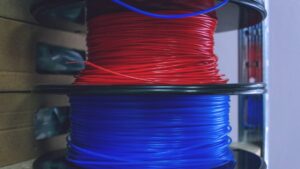
A Look at the Different Densities of 3D Printing Materials
There’s so much to learn about 3D printing materials. Come and find out what to look for when examining the different densities of 3D printing filaments.
844-810-1385
It’s likely an understatement to say that 3D printing has revolutionized industries across the globe. It has radically altered design and manufacturing processes. However, with the rise of this innovative technology, environmental concerns have come to light. Many of these concerns have to do with the materials used in 3D printing, and the popular and robust Tough PLA (Polylactic Acid) filament is not immune to scrutiny. Can tough PLA 3D Printer filament be recycled? The answer to more complicated than Yes or No. Let’s dig a bit deeper.
PLA is, without a doubt, the most popular 3D printing filament. It is easy to print, offers impressive strength, is reasonably durable, and occupies the lower rungs on the cost ladder. As a bonus, manufacturers derive PLA (and Tough PLA) from highly renewable (and biodegradable) resources like sugarcane and corn starch. These ingredients make it a green alternative to petroleum-based filaments like Nylon, ABS, and PETG.
While this is excellent news, it’s important to understand that while PLA is technically biodegradable, it requires extremely specific conditions—high temperatures and industrial composting facilities—to break down within a reasonable time frame. A PLA object may take dozens to hundreds of years to decompose in a typical landfill or home composting setup. Therefore, the widespread use of Tough PLA filament poses significant challenges to waste management and can sidetrack the progress in reducing environmental pollution if you don’t recycle it correctly.
Conscientious industries using 3D printing are exploring various recycling methods for 3D printer filaments, including mechanical and chemical recycling. These recycling methods are especially useful because they offer second lives to the used material at several levels.
Mechanical recycling involves collecting, sorting, and cleaning used filaments before chopping them up, melting them down, and extruding them into new spools. Therefore, you must mix PLA only with other PLA. Chemical recycling breaks down polymers into constituent monomers using hydrolysis or enzymatic processes—a considerably more complicated approach.
So, is it possible to recycle Tough PLA? The answer is a qualified yes. Although you, as the end-user, will not likely do it at home, you can send your scraps and rejects to specialized recycling centers.
You might also consider a simple form of mechanical recycling. Chippers and desktop extruders exist on the market today that allow you to go from scrap to filament in hours. Be aware that the final product, while still Tough PLA, may possess less desirable attributes than PLA made from virgin materials. You will eventually get dark grey Tough PLA if you mix colors that you can make darker but not lighter. Still, prototype parts for test fitting will be just fine made from this material.
Using Tough PLA is a step forward in sustainable manufacturing because it reduces reliance on petroleum-based filaments. Recycling Tough PLA is another step down the sustainability path. Perfect? No, but better than adding to a landfill.
At Filamatrix, we believe that creativity and sustainability are not mutually exclusive. Thankfully, innovative solutions exist that enable users to meet both goals. Recyclable filaments like Tough PLA offer a promising way forward with increased strength, versatility, and compatibility with recycling processes. Let’s reshape our beautiful Earth’s canvas by embracing tough PLA. Explore our filament selections and start creating with conservation in mind.
Filamatrix
NEVER. FEEL. LIMITED.

There’s so much to learn about 3D printing materials. Come and find out what to look for when examining the different densities of 3D printing filaments.

Those interested in 3D printing have a lot to learn on how to use the system properly. Find out what you need to know about 3D printing and humidity levels.

3D printing has many variables that both beginners and experts need to know. Find out what effects temperature has on 3D printer filament.
Get professional insights, industry news, and our latest deals